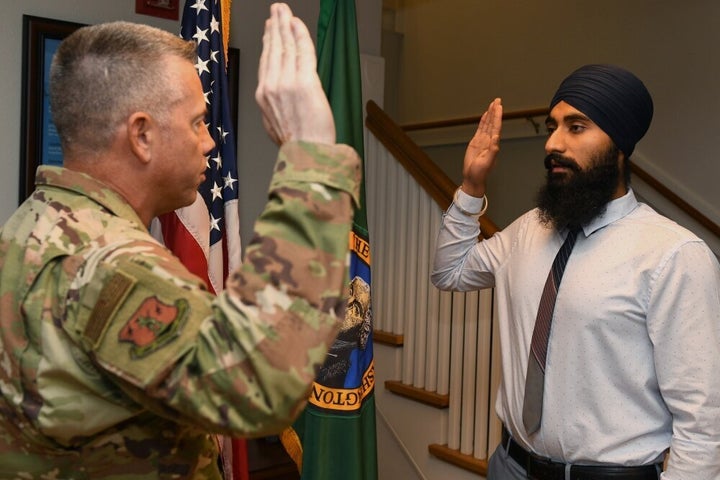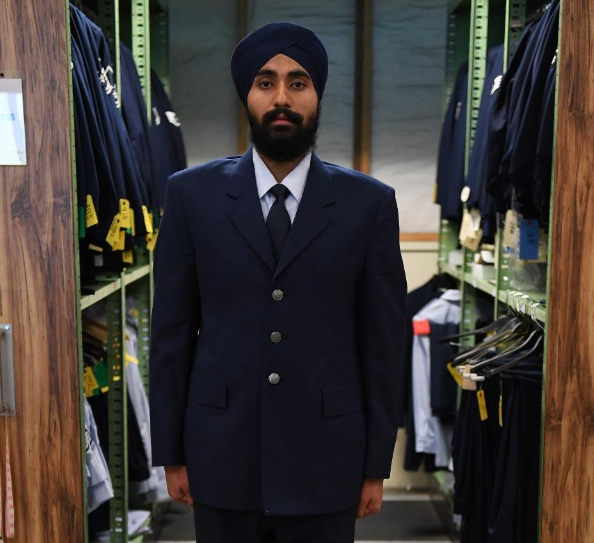The U.S. Air Force issued new guidelines on Friday giving members who wear religious apparel a way to serve the country without compromising their faith.
The Air Force’s updated dress and personal appearance policy clarifies the grooming and uniform standards for members who wear turbans, hijabs and beards for religious reasons. It also outlines the process to request these exemptions, sets timelines for management to respond, and ensures that the approvals will follow someone throughout his or her career in the Air Force.
Muslim, Sikh and pagan members of the Air Force have individually requested and received waivers for religious apparel and beards in recent years, but this is the first time the guidelines and the accompanying approval process are being standardized.
For the latest news and more, follow HuffPost India on Twitter, Facebook, and subscribe to our newsletter.
The Sikh Coalition, an advocacy group that has pushed for changes to the U.S. Air Force’s dress and appearance policy, commended the move. Giselle Klapper, a Sikh Coalition staff attorney, said her group has long been seeking a blanket proclamation that all Sikh Americans who wear turbans and beards as part of their faith can serve in every branch of the military without seeking individual accommodations. Still, she called the policy clarification a “great step forward.”
“No Sikh American should have to choose between their religious beliefs and their career ambitions,” Klapper said in a statement Wednesday.

The updated policy requires religious apparel to be “neat and conservative” and not impede an individual’s ability to perform assigned military duties or wear protective equipment.
Beards can’t exceed two inches ― if they do, they must be “rolled and/or tied” to achieve the required length, the regulations state. Hijabs, turbans and under-turbans (also known as patkas) should be free of designs and made of a “subdued material” in a color that closely resembles one’s uniform. Religious head coverings are also required to be free of designs or markings unless the individual’s uniform has a camouflage pattern.
The updated regulations mandate that faith-based religious apparel requests can only be denied for a “compelling government interest” and the denial must be the “least restrictive” way the Air Force has of achieving that government interest.
Under certain conditions, commanding officers can order the removal of turbans or hijabs to keep service members safe, the regulations state — for example, while someone is walking within 25 feet of an operating aircraft. In the event of a chemical, biological, radiological, nuclear or explosive threat, commanding officers could also ask someone wearing a hijab to remove it to ensure a proper gas mask fit.
The Council on American-Islamic Relations (CAIR) welcomed the policy change.
“Thousands of American Muslims and members of other minority faiths serve in our nation’s military and should be able to practice their faith while serving,” CAIR’s spokesperson Ibrahim Hooper said in a statement.
In 2017, the U.S. Army officially updated its dress and appearance standards to accommodate hijabs, turbans and beards.

Gurchetan Singh, the first Sikh American to secure a religious accommodation to serve in the Air National Guard, said Wednesday that he’s grateful for the Air Force’s policy change.
Singh was born in India and followed his father, an asylee, to the U.S. in 2012. Singh wanted to serve in the U.S. military to defend the country that had taken his family in, according to the Sikh Coalition. The advocacy group submitted a religious accommodation request for Singh in April 2019. It was approved in September, which means Singh will soon head to basic training.
Singh said that he believes the Air Force’s policy update will make it easier for Sikh Americans to serve while maintaining their articles of faith.
“Accommodations, after all, aren’t about special treatment ― they are about ensuring that religiously observant Sikhs and others don’t have to choose between staying true to our faith and serving our country,” he said.
